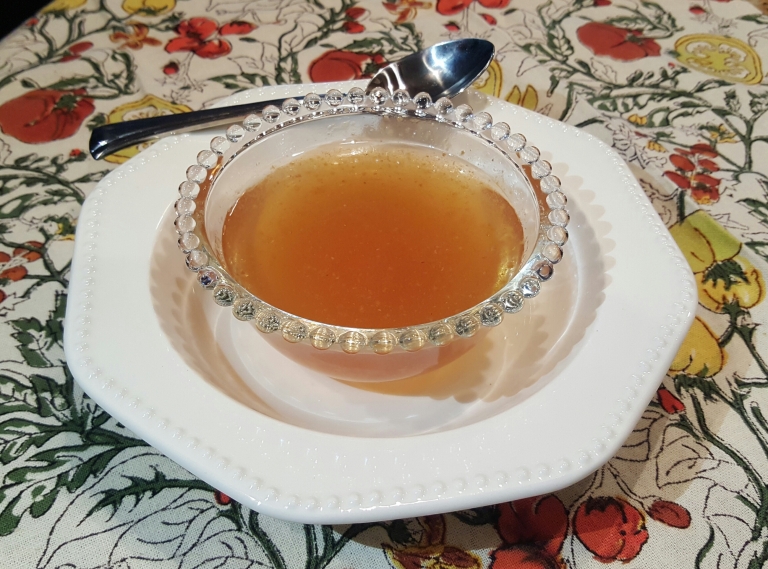Rich, Homemade Bone Broth
Dig out that slow cooker buried in the back of your cabinet and get ready to simmer up one of the best natural elixirs: slow-simmered, mineral- and nutrient-rich bone broth. You’ve probably heard that chicken soup is a great remedy for the common cold, right? (It’s also good for the soul, or so the books say.) Well, turns out, our grandmothers were right on this one…but only if it’s prepared the good, old-fashioned way (as in, using time, heat and lots of chicken bones – and some other key ingredients, which I’ll share here – and not just dumping a can of Campbell’s into a bowl, nuking it and expecting miracles).
| Servings |
|
Ingredients
- 1 whole Uncooked chicken (I buy organic, free range because the goal is to fuel yourself with as healthy food as possible. If you can find grass-fed varieties, all the better – especially for those of us with crazy food allergies. Remember: we end up eating what the animals ate.) *Like turkey better? Swap out the birds and expect the same great results – just remember that you’ll need a bigger pot for the large bones/carcass.
- 2-3 whole chicken feet and/or beaks I know…it’s not the easiest thing to see hanging out in your pot, especially if you’re an animal lover like I am, but those parts happen to be loaded with healing, immune system-boosting nutrients and gelatin). I get mine from the butcher at Whole Foods (and they’re inexpensive). Can’t findor beaks? No worries…you’ll still be able to get a hearty broth, I promise.
- 3 T. raw unfiltered apple cider vinegar I use Bragg brand – you can find it just about anywhere. Just make sure it’s the raw, unfiltered kind with the “mother”it.
- himalayan sea salt (you’ll add this to the bowl, to taste, as opposed to adding it to the slow cooker or stock pot).
- veggies (optional). I steam mine and just add them to my bowl of broth (you’re not going to add veggies to the broth as it’s cooking).
Ingredients
|
Instructions
- How you cook your whole chicken or turkey is up to you (bake, broil, boil, roast). Remove any “innards” that may be packed inside the bird and set aside (don’t toss them – they’ll be a great addition to your broth). After a thorough rinsing and patting of the bird, you can either quickly boil in a stock pot or roast it in the oven for the specified time on the package (I prefer roasting; I use a convection oven and can usually cook a chicken perfectly in less than an hour on 350°).
- Let the chicken cool enough to start removing the skin (this won’t make it into the broth) and stripping the meat from the bone. Go ahead, really get your hands in there, plucking the meat from the nooks and crannies (this isn’t a job for the faint of heart, admittedly). Place the meat in a separate bowl or container (you can add some pieces to your bowl of broth, but you don’t want to ruin it by placing it in the slow cooker for hours on end). Toss all the bones, along with any of the joints and muscle portions, into the slow cooker. For wings, which are harder to strip, I just remove as much skin as possible and toss those in as is. If gizzards (and/or the neck) came with your bird, toss those in, too. Don’t worry if you didn’t get EVERY little bit of meat from the bones; it’ll add to the flavor and you can just strain it out before jarring/ladling.
- Add cold, filtered water to your bone-filled pot, being sure to completely submerge the contents (approximately 4 quarts should do it to start).
- Now, for the secret ingredient: add 3 Tablespoons apple cider vinegar (some recipes call for two Tablespoons, but I like a little more. Don’t worry, you won’t taste it when it’s time to sip the finished product). Why the vinegar? It’s what helps draw the minerals, gelatin and other vital nutrients from the bones.
- Set the slow cooker on low heat (if you have settings that let you pick the cooking duration, select the longest one. Mine lets me slow cook for ten hours and then automatically switches over to the “warm” setting; however, I don’t let mine switch to “warm” because I keep resetting the timer round-the-clock – every 10 hours – for a minimum of 48 hours, adding another couple cups of water, as needed to prevent over-evaporation and leave you with a measly amount of broth at the end – and also to keep the broth from tasting burnt). I actually prefer cooking round-the-clock for 72 hours, though, because by then, the bones are pretty much turning to mush. The broth will be rich and hearty, and a delicious golden-brown color – unlike the awful, pale and over-priced pre-made bone broth you get at the store). Note: Some bone broth recipes call for only a 24-hour cook time. Although this is still far better than most broths you’d buy at the store, I prefer to really let those bones leach their nutrients – and that can only happen with time. The bones in the photo below were so well cooked, I could literally crust them between two fingers.
- After 48 or 72 hours, you’re broth is ready to be strained. I place a large pot in the sink, beneath a large, fine-mesh stainless strainer that really traps the pieces of bone, tissue and meat remnants. Discard the strained scrap and ladle the broth into canning jars or large glass or stainless bowl (avoid plastic, which can leach into your nutritious broth).
- Let’s EAT! Pour your liquid gold into a bowl or mug, season to taste with your Himalayan sea salt and enjoy several times a day. To keep things interesting, consider power-blending the broth with some steamed veggies (I love cauliflower, carrots and broccoli, but feel free to get creative). Avocado also makes the broth divine!
Share this Recipe


Leave A Comment